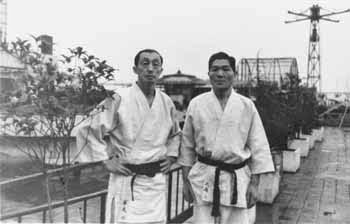Every once in a while i think you have to take a long break from Aikido, or anything else you've devoted a substantial amount of time and hot air on. You go away, and come back. You see if its doing anything to make you better at being a human being. If you are easier to get along with. If you miss doing the bare ass basics.
The basics of Tomiki Aikido have always been as far as this Okie can tell can all be found in the walking kata and the first fourteen of Yon kata.
- The Walking kata. Shodokan calls it Tegatana dosa/Unsoku dosa. Yonkata is nage no kata omote/ura.
The footwork. If you watch Tomiki do it You'll see a step in, and a step back. I've seen books where the step forward and the step backward are exactly one footspan. A step back to keep from getting cut by a guy taking one step forward. A step forward to enter a space, fundamentally its where a sword guy raises the sword over head and you stiff arm him.
These two Shodokan dudes show a lot of footwork. The third move represents the step in. A single step that puts a guy at a disadvantage. Call it off balance, or kuzushi. Call it a free move. Most of the time the attempt to make things equal, or the attempt to use strength in a compromised posture lead to a technique.
The other walking steps represent standardized ways of " getting the hell out of the way." You can see a lot unsoku/walking kata in Tomiki's sword snatching along with the Sword Fighting parts of San kata. They aint exactly unsoku but they might be in a neighborhood.
Every principle in the Tegatana movements has an opposing principle in the 8 releases/Yon Kata/shichihon Kuzushi. Sword work, and sword snatching represent Timing. Where the sword vs sword represents proactive timing: Its footwork and hands working in unison to yeild an advantatge. The sword snatching is footwork alone and the contortions of the wrist and the various avenues of snatchint the sword give rise to wrist locking ideas.
Pair a Yon kata move with a sword swing. The hand on hand relationship isnt a method of escape. Imagine a timing where your sword is underneath another sword. The footwork represents away of vacating the space where a thrust can occur to precipitate a circular cut thereby making the situation predictable and malleable.
The circular hand movements and hand positioning in Yon kata reflect hand positions in the Walking Kata/Tegatana dosa. Yon Kata is a deeper study of the Tegatana movements. In the first two movements represent a daito ryu aiki age/ aiki sage type movement except they are paired with a step in or a step back. A hand/sword thrust to the throat, or a controlled release of a sword stroke downward. The Throw is just to show off, and is more abstract than practical. The principle here is to disappear inside of the arc of the sword cut. A difficult and ballsy move, but the typical sequence in Tomiki Aikido tends to show the most comprimised position or timing first, rather than the basic position first.
As far as opposites go, reference the aiki age movement with the sword rise position in Tegatana Dosa. Answer a rising sword with a sword to the throat. The next is releasing the opponents sword downward. Both represent the very basic off balances in aikido. Spine lock or waist bent down the line of the toes. The positioning for the throw disappears within a sword arc and in some schools adds a drop to the knee for added insurance against getting your head cut off.
In movements three to four represent the preference of getting at a dead angle, outside of the sword arc. The stepback represents releasing an opponents sword downward. The shomenate hand movement represents closely the angle in the sword vs sword. Where you have an advantage of your sword being on top. The turning movement is a way of vacating out of a bad position. You can say the same thing about the first two.
The karate chop palm downward in tegatana finds its opposite in movement three and four. (release 1, 3)
Moves are combined as if they are one singular concept. Which is why they make sense, but they dont. A duality. But all aikido from a hand on hand relationship represents both sword and jo/spear concepts, and advantage and disadvatage. a straightline and a circle. They are not grab escapes.
The movement five and six represent the offered hand. An invitation to attack. They also live inside the first two hand movements when you move from inside the sword arc to the outside of the sword arc. Also note in the Nariyama video that the commonality of his initial hand positioning pre-grab is either starting in an offered hand palm up, or transitioning to an offered hand palm up. Anyway, they oppose the chopping action in Tegatana where the palm is up. (release 2, 4)
The counter movements mirror very closely situations in the sword snatching parts of san kata. But they also seem very similar to certain jodo movemets where the sword player cuts from a position of disadvantage and his energy is released into a finishing technique.
Anyway, I'm sure there is more to see. But Yon kata isnt about hand grabs and crazy throws.
